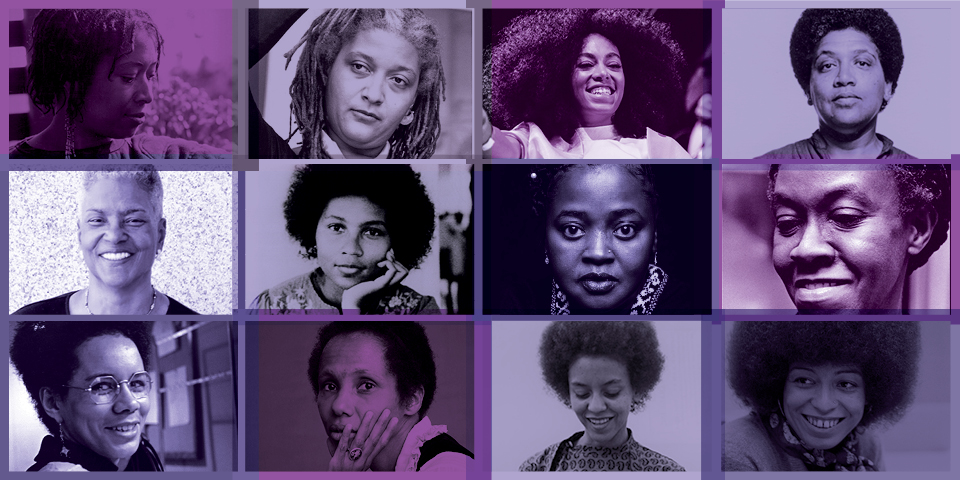
Left to right from top: Alice Walker, Jewelle Gomez, Solange, Audre Lorde; Cheryl Clarke, bell hooks, Sister Souljah, Gwendolyn Brooks; Kathleen Collins, Adrienne Kennedy, Nikki Giovanni, Angela Davis.
A QUIET REVOLUTION
By Sabine Decatur, Production Dramaturg
When playwright Christina Anderson describes her character G.K. Marche—a writer in the late 1960s—as “a singular voice that explores the revolutionary act of Black intimacy in a climate of Black rage,” shen is describing herself too. Today’s social and political climate often feels full of rage—justified rage and productive rage and necessary rage but rage nonetheless. In 2019, How to Catch Creation feels unusual: it is a play that celebrates love, joy, heartbreak, creativity, passion. It centers Black people without centering Black pain.
The American Theater has a long history of sensationalizing Black narratives of struggle. From slavery melodramas of the 19th Century, to shows like Porgy and Bess in the early 20th Century, and even to contemporary plays that critique modern structures of racism, the images of Black people that we see onstage tend to be long-suffering, in poverty and in pain. Even in Black stories, white supremacy still finds its way to the center. How to Catch Creation is a radical departure from this backdrop of American Theater. By writing Black characters who are middle-class, successful, and flourishing in their talents, Anderson commits the revolutionary act of representing Black people as people: people who have messy love lives, drink too much wine, and make art.
As Anderson points out with the character of G.K. Marche, artists—especially
Black women artists and especially Black queer women artists—have been doing this work for a long time. In a world that disregards their humanity, Black women have been blossoming beautiful interior lives, insisting on softness even under powerfully racist conditions.
Iconic poet Gwendolyn Brooks dedicated her career to representing the ordinary lives of Black folks. Written during the height of Jim Crow and on the cusp of the Civil Rights Movement, her books Annie Allen and Maud Martha follow “unexceptional” Black girls who fall in love, pursue their dreams, and have sometimes mundane experiences.
In 1950, the year Brooks became the first African-American to win the Pulitzer Prize, her editor asked what made her write. “To prove to others (by implication, not by shouting) and to such among themselves who have yet to discover it,” she said, “that they are merely human beings, not exotics.”
Writer and filmmaker Kathleen Collins carried Brooks’s legacy forward into the 1980s. Her film Losing Ground flopped when it premiered in 1982, at least in part because it defied expectations of what a Black movie should be. Following the complicated relationship between a professor and an artist, each struggling to find fulfillment in their personal and creative lives, the film doesn’t make race its central problem but rather carefully investigates the ways that race, gender, and sexuality impact a particular Black woman’s life. Despite her obvious genius, Collins’s work had been largely forgotten until recent posthumous publications of her writing. America wasn’t ready to see Black people grappling with the same big questions that white artists ask in their work.
Artists like Collins and Brooks paved the way for the range of Black stories we see in popular culture today—from television like Atlanta to films like Black Panther to musicians like Jamila Woods. Even Solange, one of today’s biggest recording artists proclaims the facets of her own interiority:
“I can’t be a singular expression of myself, there’s too many parts, too many spaces, too many manifestations, too many lines, too many curves, too many troubles, too many journeys, too many mountains, too many rivers, so many…” Like Solange, How to Catch Creation’s characters contain so many multitudes—just as many as white characters have been afforded throughout all of American theater history.
Director Nataki Garrett describes How to Catch Creation as a quiet revolution. She observes, “The play asks, ‘What does it mean to create a world in which people who are normally othered exist without the lens of the status quo?’ That right there is a revolution and a revelation.”



